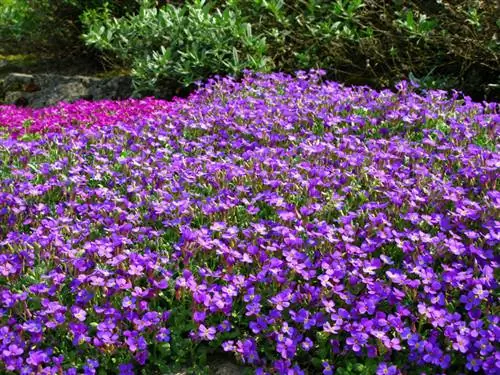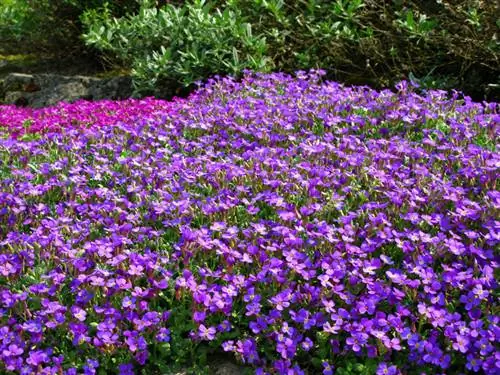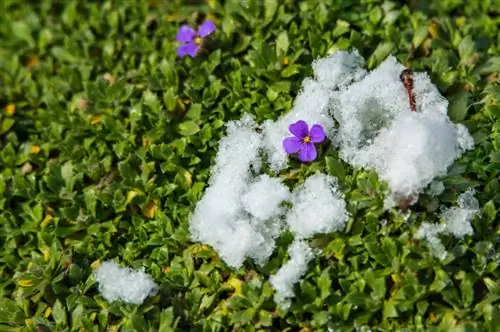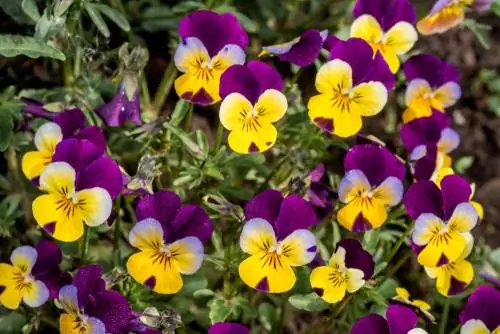- Author admin [email protected].
- Public 2023-12-25 17:45.
- Last modified 2025-01-23 11:22.
Blue cushions transform barren masonry crowns, dreary stone structures and other orphaned sunny areas into a lush sea of flowers. In order to extract the floral power from the delicate ground cover, the gardener hardly needs any significant work. The following answers to frequently asked questions shed light on all relevant aspects.

How do I care for blue cushions properly?
Blue cushions are undemanding ground cover plants that prefer sunny locations and bloom profusely from April to May. Care includes sparing watering, initial fertilization in March, pruning after flowering and light winter protection in the year of planting and in the pot.
Planting blue cushions correctly
As this year's gardening season comes to an end, the planting time for blue cushions begins. In a sunny location, loosen the soil to add compost, horn shavings, sand and rock dust if necessary. Since a single Aubrieta looks so lost, we recommend an arrangement in small tuffs with 3-5 specimens. To do this, dig spacious planting holes at a distance of 30 cm, then pot up the young plants and place them in the enriched substrate. Press the soil down with your hands and finally water it with normal tap water.read more
Care tips
The exuberant abundance of flowers makes us believe that blue cushions are high-maintenance. In fact, the perennial is pleasantly undemanding. The following overview lists all the important care factors:
- Water the blue cushion only with normal tap water during prolonged dry periods
- Starting fertilization with compost, horn shavings and algae lime in March covers the nutrient requirements in the bed
- Add liquid fertilizer to the water in the pot every 2-3 weeks from March to July
- Pruning after flowering creates the conditions for autumnal re-blooming
- Cut the perennial close to the ground in January/February
Although Aubrieta are completely hardy, we recommend light winter protection in the planting year and every year in pots and flower boxes.read more
Which location is suitable?
Blue cushions are sun worshipers straight out of a picture book. The more sun the Mediterranean ground cover can absorb, the more magnificent the flower carpet will develop. The perennials feel particularly at home in a sheltered location in front of the south wall of the house, because even summer heat does not affect their vitality. In addition, the soil should be well-drained, moderately nutrient-rich and calcareous. Aubrieta also feels at home along a sun-drenched wall, on the roof garden or in the gravel bed.read more
The correct planting distance
In the right location and lovingly cared for, blue cushions thrive significantly more in width than in height. With an average height of 10 cm, this quickly adds up to 30 cm in width. When choosing the planting distance, pay attention to this fact in order to achieve a dense flower cushion. With a planting distance of 25-30 cm you are exactly right. For a flat arrangement, plant 11 specimens per square meter.
What soil does the plant need?
When choosing the location, coordinate the lighting conditions and the soil conditions. The sunnier the location, the fresher the soil should be. In addition, a medium to high lime content is essential for vigorous growth and abundant flowering. You can determine the pH value in the soil using an uncomplicated test set (€14.00 on Amazon). A result between 6, 5 and 8 is desirable. If the quality of the soil is not optimal, use soil additives to compensate. Soil that is too lean is enriched with compost, bark humus and horn shavings. Wet, greasy soil can be thinned out with sand, fine grit and add rock dust or algae lime.
What is the best time to plant?
Autumn is the ideal planting time for Aubrieta that you grow yourself or buy ready-made. In September, dig a small hole in the garden soil and place your hand in it to feel the heat stored there. Under these conditions, the Mediterranean blue cushions naturally root quickly. If you miss the deadline between the end of August and mid-October, you can plant the enchanting ground cover from the end of April/beginning of May.read more
When is flowering time?
Blue pillows spoil us with a colorful blooming period from April to May. If you can't get enough of the abundant carpet of flowers, cut the perennial back at the beginning of June. A large number of magnificent hybrids have the potential for autumnal re-blooming, which can be initiated by timely pruning.read more
Cut blue pillows correctly
With a cut at the right time, you can complete two key maintenance measures in one step. If you cut back the withered flower pads at the end of May/beginning of June, your effort will be rewarded with magnificent re-blooming in autumn. At the same time, you save the busy flower beauties from the strenuous growth of seeds and prevent self-sowing. To enjoy the winter green carpets during the cold season, cut the perennial close to the ground on a frost-free day in January/February.read more
Pouring blue cushions
Mediterranean flower artists are not affected by drought stress in the long term. Although blue cushions can tolerate short-term drought, they should be watered every now and then, especially during hot summer days. In the early morning or late evening, pour normal tap water directly onto the root disc using the can nozzle. This measure is required more often for Aubrieta in pots and flower boxes than in the open field. This is especially true in a location surrounded by air, which allows the potting soil to dry out quickly.
Fertilize blue cushion properly
An excessive supply of nutrients causes premature aging of blue cushions. Therefore, limit fertilization to an application of compost with horn shavings in March. If you add a handful of rock dust or algae lime, the perennial will be completely satisfied with it. In the limited substrate volume of balcony boxes and tubs, supplies are used up more quickly. Apply a liquid fertilizer for flowering plants every 2-3 weeks from March to July.
Diseases
The most common cause of a he alth problem in blue pillows is the widespread fungal infection mildew. As an unmistakable symptom, the delicate leaves are covered with a mealy-white coating. Milk spraying has proven to be an effective control measure. Mix 1 liter of water with 125 ml of fresh milk. If you spray this mix repeatedly on the top and bottom of the leaves, there is a good chance of saving the perennial. It is an advantage if you cut off the already infected shoots beforehand and dispose of them with household waste.
Wintering
The abundance of flowers belies its robust winter hardiness. In fact, blue cushions can endure bitter frost down to -17 degrees Celsius. We still recommend light winter protection in the year of planting and in the pot. Cover the young perennials with leaves and coniferous twigs. Place a block of wood under the planters and wrap them with bubble wrap. A colorful winter coat made of jute is beautiful to look at and creates an eye-catching appearance in combination with the wintergreen foliage.
Propagate blue pillows
If the abundance of flowers has captivated you, you can easily grow new blue cushions. Choose from the following methods:
- Dividing the root ball in spring or autumn
- Cut cuttings in April or May to let them root in a small pot until autumn
- Growing by sowing on the windowsill from February at a constant 20-22 degrees Celsius (not possible for all varieties)
Sowing directly in beds and balcony boxes is also possible and easy to carry out. At the end of April/beginning of May, prepare a fine-crumbly substrate, scatter the tender seeds and sift them thinly with sand or vermiculite. Moistened with a fine spray, germination progresses quickly in a warm, partially shaded location. In the open field, a close-meshed net protects the sowing from pecking birds and voracious snails.read more
How do I transplant correctly?
If a blue pillow is taking care of itself, there is no reason not to change location. Dig up the root ball in spring or fall. If some parts are already bare, simply cut them out. Then plant the perennial in a sunny location in the permeable, sandy-loamy soil and water with tap water.
Blue pillow in the pot
In the pot and balcony box, blue cushions create a picturesque appearance as dense, hanging flower cushions. Use a lean standard soil TKS1 as a substrate. Commercially available potting soil is thinned with sand, expanded clay or lava granules. To prevent waterlogging, place a curved piece of clay over each water drain and fill in the soil over it. Arrange the potted young plants at a distance of 20 cm, a little closer to each other than in the bed. Placed in a sunny, warm place, water the perennials when it is dry. Add some liquid fertilizer to the irrigation water every 2 to 3 weeks. Pruning after the first flowering will produce autumnal re-blooming for most hybrids. To protect against frost and moisture, cover the pot and flower box with foil or jute ribbons. A base made of wood or Styrofoam keeps the cold of the ground away from the root ball. If the beauty of the blue-green foliage leaves something to be desired in late winter, cut the perennial down to the ground to make room for the fresh shoots.
Is blue pillow poisonous?
You don't have to worry about toxic content with blue pillows. The Mediterranean perennial is harmless in every respect. The flower is therefore recommended as an ideal spring bloomer for the family garden. If your four-legged household members nibble on it, there is no reason to worry as long as cats, dogs and rabbits do not eat the flowers and leaves in large quantities.read more
Beautiful varieties
- Red Carpet: Purple-red favorite variety that blooms profusely and develops particularly dense cushions; Growth height 8-10 cm
- Blue Tit: Distinctive spring beauty with blue-violet flowers and winter-green leaves; Growth height 5-10 cm
- Downer’s Bont: Cheerful, colorful play of colors with white variegated leaves and purple flowers; Growth height 8-10 cm
- Havelberg: Spring-fresh opulence thanks to double flowers in delicate pink for compact cushions; Growth height 5-8 cm
- Kitty: Impresses with extra large flowers in violet-blue that stand out on the tops of walls; Growth height 5-10 cm
- Winterling: Picturesque hybrid with double flowers in bright white for sunny locations; Growth height 5-10 cm






